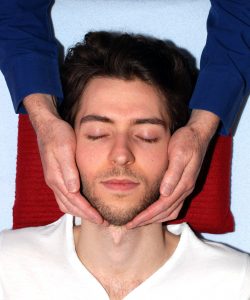Thomas Attlee’s book “Face to Face with the Face” explains how Cranio-Sacral Integration can help a wide range of persistent and painful conditions involving the face and the cranial nerves – from trigeminal neuralgia, sinusitis, hearing loss and TMJ syndrome to autism, chronic fatigue and polyvagal disturbance – through a deeper understanding of quantum levels of health and the biodynamic forces which underlie the body’s inherent healing potential.
When you experience discomfort or concerns relating to your teeth or jaw, you will probably be inclined to go to a dentist. This is of course to be expected, and is appropriate for many dental issues. Modern dentistry brings substantial benefits and there are a great many excellent dentists carrying out very good work.
In everyday cranio-sacral practice, however, one encounters many patients with a variety of issues involving the teeth and jaw – persistent tooth pain, temporo-mandibular joint disturbances, facial pain – that have not been resolved through conventional dentistry.
It is also common to encounter patients with concerns as to whether the major dentistry or orthodontic treatment that has been recommended to them is appropriate or necessary. In order to establish an appropriate response to these circumstances which will be of greatest benefit to the patient, we need a thorough understanding of the often complex interactions that may be involved.
Local symptoms in the teeth, jaw, or temporo-mandibular joints (TMJ) may often arise from sources elsewhere in the body, and yet are generally (and understandably) treated as local disturbances – as a result of which a great deal of unnecessary and inappropriate dentistry and orthodontics may be carried out – while the true source of the symptoms remains unidentified.
Conversely, disturbances to the teeth, jaw, or temporo-mandibular joints can have profound debilitating effects on the whole body and on general health. Often there may be no local symptoms in the teeth and jaw, rendering the source of the disturbance potentially difficult to trace – as a result of which such cases are often not recognized.
For effective health care, it is essential for the practitioner – dental practitioner, cranio-sacral therapist
or any other practitioner – to acknowledge this two-way interaction and to develop the necessary skills to evaluate whether the situation will be most effectively addressed through dentistry, cranio-sacral therapy, or a combination of the two, and perhaps other therapies also.
As dentist John Laughlin reports:
“As dentists we are taught to analyse body systems and body parts separately. We are taught to change one area at a time, but such approaches frequently ignore the interconnectedness of the systems in the human body” ¹
Another experienced dentist reports:
“Cranio-sacral therapy resolves 90% of the problems that I see”. ⁷
Accurate assessment:
It is therefore necessary in every case to make an accurate assessment of the whole person – evaluating both local and distant causes, dental and whole-body patterns, acknowledging and addressing stress factors, accurately identifying the source of the issues – whether in the jaw, elsewhere in the cranium, elsewhere in the body, or in the psycho-emotional state – and for the practitioner to ensure that the patient receives treatment appropriate to their situation, rather than merely carrying out what he or she has been trained to do.
As dentist John Laughlin concludes:
“Cranial therapy is beneficial for all dental patients, and should be included in most if not all dental regimens. The body needs to be viewed as an entire structure and the dental professional (dentist, orthodontist, or oral surgeon) must be encouraged to understand and consider this interrelatedness.”
Dr Granville Langly-Smith – specialist orthodontist:
“Dentistry and cranio-sacral therapy can play a massive role in working together. No one person can treat everything, but by forming a team – especially in the treatment of young children who have malocclusions with a compromised cranial system and other such debilitating situations – dentists and cranio-sacral therapists, working cooperatively, can have remarkable results in helping those children (and adults) to develop normally and healthily into nature’s design.”
Dr Dietricht Klinghardt MD. PhD:
“Cranio-sacral therapy is excellent, and this cranio-sacral treatment, if used correctly, can be good for a patient, especially the developing child. However, cranio-sacral therapy combined with good dentistry can be nothing less than awesome!”
Dr Wojciech Tarnowski – dentist:
“Cranio-Sacral Therapy, with a little help from appropriate dentistry and an awareness of how the vestibular system works has the potential for being the most effective holistic therapy of all by restoring homeostasis. ”
Case Study 1: Caroline, Tooth, jaw and TMJ pain
Case Study 2: Catriona, Hearing Loss
Case Study 3: Milosz, Trigeminal Neuralgia
 Thomas Attlee is founder and principal of the College of Cranio-Sacral Therapy, London, the first and most established college of Cranio-Sacral Therapy in Europe, now in its 31st year. He is the author of “Cranio-Sacral Integration – Foundation” and the newly published “Face to Face with the Face”. www.ccst.co.uk
Thomas Attlee is founder and principal of the College of Cranio-Sacral Therapy, London, the first and most established college of Cranio-Sacral Therapy in Europe, now in its 31st year. He is the author of “Cranio-Sacral Integration – Foundation” and the newly published “Face to Face with the Face”. www.ccst.co.uk
